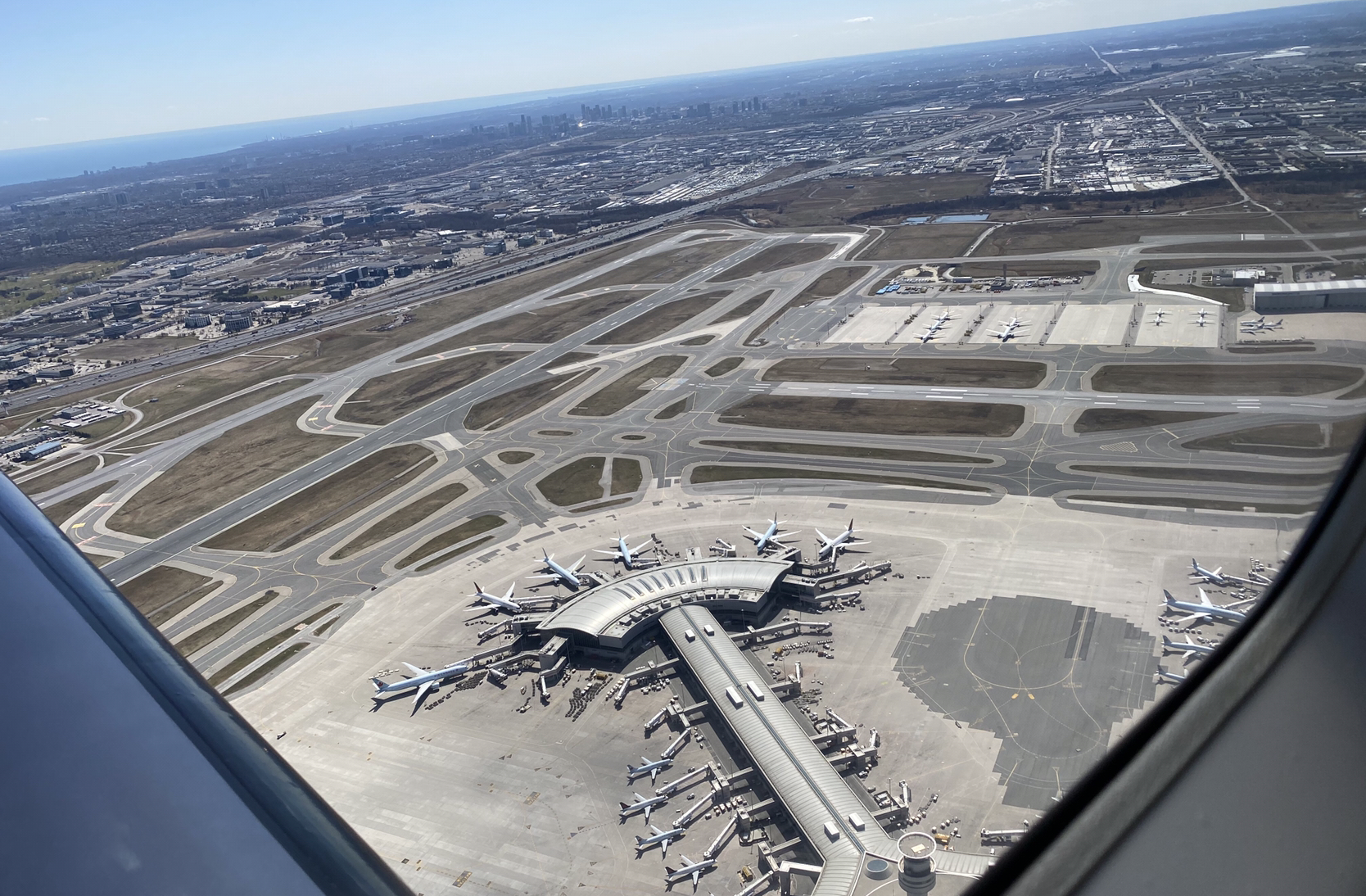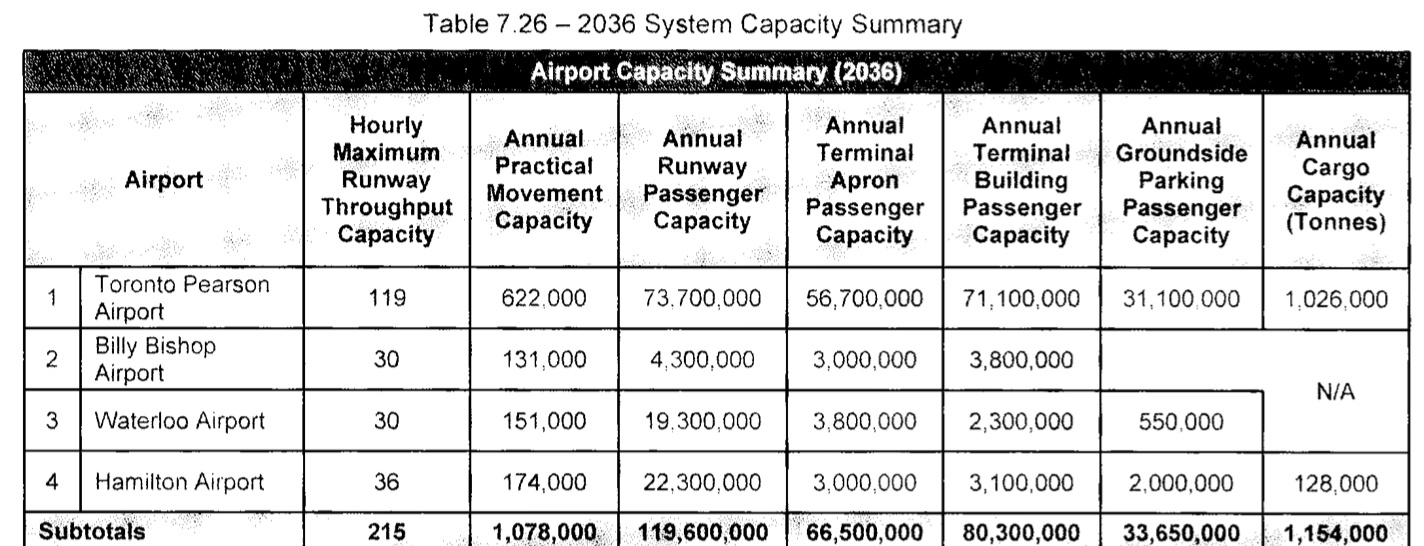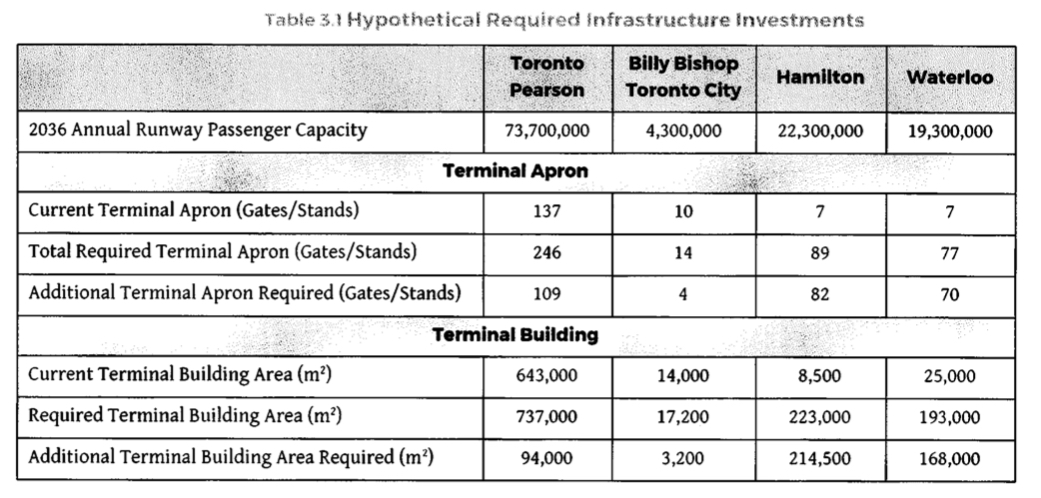
On March 5, 2020, Transport Canada released the Pickering Lands Aviation Sector Analysis (the Study). It was much awaited, and hopefully will be the definitive study on the need for and timing of a new commercial airport in Pickering, Ontario. Its message is simply, “The question is now when, not if, a new airport should be built”.
To answer that question, it follows a political directive that has upset local political and business leaders for years, the “Build Pickering Airport Last” strategy. This unnecessarily muddles the Study’s pro–Pickering result and perpetuates regional rivalries.
The idea behind “Build Pickering Last” is to steer development to other communities that already have airports. This includes Hamilton and Waterloo, both smaller cities, located hours away from the eastern Toronto communities lobbying for locally accessible aviation infrastructure. Surprisingly, there is not a business case for this redirection, in stark contrast to the strong business case included in the study for building a new airport in Pickering.
So, now what happens? Anyone with a casual interest in a Pickering Airport can see the anti-airport folks celebrating. It is they who have championed the “Build Pickering Last”, and preferably “Never”, political strategy. They are celebrating the Study’s conclusion that maximizing capacity elsewhere could delay the need for Pickering Airport’s passenger capacity to 2036. Yet the local pro–airport residents, business and political leaders are also celebrating the study’s suggestion that construction should start in 2026. The airport is expected to enter service in stages as early as 2028 but not later than 2034, with that timing development scenario–dependent.
How can both sides be celebrating? At first glance, the Study commissioned by Transport Canada and prepared by KPMG-WSP hits the sweet spot for both groups. But the real victor is the side that answers this question:
“Where Are the Business Cases?”
The Study lends credence to the Pickering airport development scenarios by including a supportive 135-page revenue generation and economic impact report, a.k.a. the “Business Case”. As to its “not before 2036” conclusion, the Study states that, based on its own evaluation of the ability to maximize the passenger capacities of four other regional airports (Pearson, Waterloo, Hamilton and Billy Bishop), expansions in aircraft apron and air terminal facilities will permit the existing network to satisfy a projected 2036 passenger traffic forecast.
For the anti-airport folks, the Devil is in the details, and the Devil is about to expose the flaw in this argument.
All four airports have Master Plans, but the Study requires expansions well beyond those plans. The Study states that Toronto Centre Billy Bishop Airport has some but very limited potential to increase its capacity, so it will not be a major contributor to addressing air traffic growth to 2036. The GTAA’s Master Plan for Pearson identifies its current capacity as 65 million passengers per year, increasing to 85 million by 2037. The Study lists Pearson’s current capacity as 53.1 million. The Study’s focus on a few capacity factors totally misses the real long-term constraint on Pearson – the need for a multi-billion-dollar investment in a Regional Transit Centre and public transit systems to get people to and from the airport.

The Study’s position on the current and future capacities of Waterloo and Hamilton is truly perplexing.
The master plan for the Region of Waterloo International Airport indicates its current capacity as 250,000 passengers annually, increasing to 2.5 million by 2034. To achieve this, 15 more gates are now in plan. Amazingly, the Study shows Waterloos capacity as 19.6 million, 77 times larger than today and 8 times larger than what is in its master plan for 2034. To handle this 8–fold increase in its plan Waterloo would need to ad 50 more gates with proportionate services including terminal, tarmac, parking, transit and fuel farm all by 2034.
The master plan for John C. Munro Hamilton International Airport indicates a capacity of 1.5 million passengers annually by 2027. Considering significant upgrades already implemented and those planned for the near-term, Hamilton could possibly handle that volume of traffic now. However, the Study indicates the current capacity of Hamilton as 17.7 million passengers annually, 12 times more than the airport’s master plan.
To understand this huge discrepancy in the values for the current airport capacities at Waterloo and Hamilton, one must dig into the Study’s analysis of capacity. The Study determined capacity by discrete and isolated evaluations of just four airport elements: the runways, the aprons, the passenger terminal and car parking.
The study then determined an airport’s current capacity by selecting the element that was the LEAST restrictive. In every case, it was the runway capacity that was determined to represent the airport’s capacity.
This tactic ignores that airports are incredibly complex operations integrating dozens of facilities, processes, practices and regulations. The Study’s choice of the LEAST restrictive element rather than the MOST restrictive results in the combined current capacity of Waterloo and Hamilton being overstated by 36 million passengers per year. The issue becomes compounded when the Study then suggests building out the apron and terminal facilities to the runway capacity level to set the 2036 passenger capacity. And those facility expansions will not be modest.
Time for a reality check.
The Region of Waterloo, a community of just over 600,000 people about 90 kilometres west of Toronto with an independent airport and master plan pointing to 2.5 million passengers in 2034, is now presented with a Study conclusion that it needs to be 19.3 million by 2036 just to delay development in a community 2 hours away.
Similarly, the City of Hamilton, with a population of 579,000 in 2017 and an airport master plan of 1.5 million passengers by 2027 is given a new target. The Study conclusion says the airport capacity needs to be 22.3 million by 2036.
These expansions must occur if Pickering Airport’s passenger terminal is to be delayed. Further, no business case is presented to entice either Hamilton or Waterloo to risk such an expansion. The downside risk is that both communities could be saddled with supporting a Mirabel-style airport, too expensive for local aviation, and too far from downtown Toronto to attract air traffic anywhere near the volumes stated in the Study.
So, what are the tremendous things that are about to happen that will cause Waterloo and Hamilton to change their master plans? Why should they spend many hundreds of millions of dollars each to expand the capacities of their respective airports to 25 to 30 times the forecasted population of their communities by 2036? Would these airports be viable? On this, the Study is silent.

It’s curious that after hearing the anti-Pickering Airport folks clamour for a business case, the Study delivers one for a new airport in Pickering and then flips the issue on its head by imposing the question:
Where are the business cases for expanding Waterloo and Hamilton airports to the Study’s 2036 capacities?
Since there are no business cases for expanding these two airports, the “Build Pickering Last” strategy is officially dead. The only viable business case for expanding passenger aviation in the Toronto region is to build a new airport in Pickering. It is time to congratulate the local civic leaders who have called for an end to the regional rivalry and discrimination for years. Now all they have to do is beat a pandemic.
references :
Current Hamilton Airport Masterplan
Current Waterloo Airport Masterplan
My how you do blather on.
The only valid calculation is Toronto runway max. capacity. It all falls out from that.
Show me that KPMG annual max capacity calculation and result for the 6 runway airport and the projection to time limiting date in 1 line..
Then explain it in another 1 line..with sources.
Bet you can’t… or won’t??
Runway capacity is a red herring, the real issue is the strong business case for building Pickering versus a nonexistent one to build out Hamilton and Waterloo.
The tyranny of geography wins again.
Answer .. Won’t. Runway Capacity at Toronto is the core issue. That is why you never answer the question. There is no business case for Pickering. Never was. Never will be.
All the information and reasons provided in the latter sections of KPMG can be substituted and used for the business case for Oshawa. They are compelling and Oshawa can proceed today at zero cost on the basis of a signature. Oshawa is rational, now and into the future. Pickering is not and becomes increasingly foolish as Oshawa grows.
Your whole case for years has been Toronto /Pickering. It has been reduced to Pickering /Oshawa and it still fails.
Durham Region has spent years on a pipe dream. That has to stop.
Here is the calculation from GTAA master plan 2008……. 5 runway airport based on their 2008 numbers and formula. page 5-11
( .79 x (56+70))+(.14x(48+60))+ (.06×75)+(.01×30) = 119.46 av. Moves /hr. and 119.46 x 18 x 365 x1.03= 808,397.8 max annual capacity.
Translation : E/W runway 79% of time in VFR conditions hourly capacity is 56 on the N parallel plus70 on the S twin. PLUS. 14% of the time in IFR conditions that capacity reduces to 48 +60. PLUS. 6% of the time the N/S twin will be in use with capacity, 75 moves /hr. and PLUS 1% of the time the max capacity is 30 /hr due extreme weather conditions maintenance etc. This is then multiplied by their 18 hour day, their 365 day year and the 3% night time allowance.
Sorry I couldn’t get it into one line.
In 2017. 20 yr plan Toronto advised they could do ~90 moves /hr on the NS twin. That given and using their 6 runway formula this becomes: as from same 2008 master plan and updated.
( .79 x(84+84))+(.14x(72+72)) +(.06×90)+(.01×30) = 158.58… and ..158.8 x18 x365 x 1.03 = 1,073,126.8 max annual capacity.
Note; the EW twin uses slightly reduced #s due taxiway clearing issues (75 becomes 70 thus 90 becomes 84) according to GTAA.
Toronto is at 473,000 annual movements (annual report) growing at less than 2% annually. Their last stated annual capacity is 615,000 depending on where you choose to read it. …….. I figure that to be fraud by definition.
Chanting a mantra Over and over again doesn’t make it true.. “ there is no business case” for 10x Hamilton and Waterloo. There is most certainly multiple business cases for Pickering.
Durham region is never going to let go of having its own airport nor should they. Every major region/city needs and deserves a locally accessible airport. The fact that competition from other parts of Southern Ontario uses access to local accessible aviation to divert business and people away from Durham reinforces the need for the airport.
This is a political equality issue that only gets solved by building a real airport able to take wide body jets ( that’s min 8500 ft runway, something oshawa can never Do as oshawa it is surrounded by homes and businesses ).
But you know all that, you also must know the facts do not match your math. So why continue? What is with the fixation on oshawa?
Nobody cares about “political equality” over airport access. Come on….
Oshawa is legal, B Bishop is legal Hamilton is legal. Pickering is not as per article 44 of GTAA /TC ground lease. see “GTAA publications”
Oshawa is capable now and has a future. See You tube “Plane spotting London City”. Wide bodies not required.
You are the Chanter of Mantras endlessly. ,.. not me. I reference articles , you spin stories and ref. yourself.
PS nobody has built a commercial pax. jet since Concord.
Hi Ivan,
explored article 44 years ago here:
https://pickeringairport.org/493-2/
But the moment Pearson applied Business jet restrictions in 2019 it became invalid, so pickering is legal and good to go.
See:
https://pickeringairport.org/business-and-general-aviation-at-pickering-airport/
And at any rate the GTAA is now calling for the development of Pickering airport, even though they will not be allowed to do it.
https://pickeringairport.org/somac-announced-gtaa-joins-voices-calling-for-pickering-airport/
But after the pandemic who knows?
Stay healthy!
;-))) Like I said you talking to you….. as in Closed loop on BS.
SOMAC. Hillary Marshall’s little group. GTAA Vp stakeholder relations… politicians all. OLD TBOT stuff.
Not an aviation pro in the lot. Same group that said Toronto at total capacity in 2019…
She slings it faster than you.
Grounded?? no more photos?
Belittling language and misdirection do not change well researched and source quoted facts.